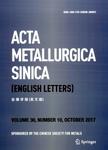SUBSTRATE EFFECT ON HYDROGENATED MICROCRYSTALLINE SILICON FILMS DEPOSITED WITH VHF-PECVD TECHNIQUE
SUBSTRATE EFFECT ON HYDROGENATED MICROCRYSTALLINE SILICON FILMS DEPOSITED WITH VHF-PECVD TECHNIQUE作者机构:Department of Electronic Engineering Jinan University Guangzhou 510632 China
出 版 物:《Acta Metallurgica Sinica(English Letters)》 (金属学报(英文版))
年 卷 期:2006年第19卷第4期
页 面:295-300页
核心收录:
学科分类:0817[工学-化学工程与技术] 0806[工学-冶金工程] 08[工学] 0807[工学-动力工程及工程热物理] 080501[工学-材料物理与化学] 0805[工学-材料科学与工程(可授工学、理学学位)] 0802[工学-机械工程] 0703[理学-化学] 0811[工学-控制科学与工程]
基 金:This work was supported by the National Key Basic Research and Development Programme of China (No. G2000028202 and G2000028203) Guangdong Provincial Natural Science Foundation of China (No. 05300378) Programme on Natural Science of Jinan University (No. 51204056)
主 题:hydrogenated microcrystalline silicon film VHF-PECVD (very high frequency plasma-enhanced chemical vapor deposition) substrate effect
摘 要:Raman spectra and scanning electron microscope (SEM) techniques were used to determine the structural properties of microcrb'stalline silicon (μc-Si:H) films deposited on different substrates with the very high frequency plasma-enhanced chemical vapor deposition (VHF-PECVD) technique. Using the Raman spectra, the values of crystalline volume fraction Xc and average grain size d are 86%, 12.3nm; 65%, 5.45nm; and 38%, 4.05nm, for single crystalline silicon wafer, coming 7059 glass, and general optical glass substrates, respectively. The SEM images further demonstrate the substrate effect on the film surface roughness. For the single crystalline silicon wafer and Coming 7059 glass, the surfaces of the μc-Si:H films are fairly smooth because of the homogenous growth or h'ttle lattice mismatch. But for general optical glass, the surface of the μ-Si: H film is very rough, thus the growing surface roughness affects the crystallization process and determines the average grain size of the deposited material. Moreover, with the measurements of thickness, photo and dark conductivity, photosensitivity and activation energy, the substrate effect on the deposition rate, optical and electrical properties of the μc-Si:H thin films have also been investigated. On the basis of the above results, it can be concluded that the substrates affect the initial growing layers acting as a seed for the formation of a crystalline-like material and then the deposition rates, optical and electrical properties are also strongly influenced, hence, deposition parameter optimization is the key method that can be used to obtain a good initial growing layer, to realize the deposition of μc-Si:H films with device-grade quality on cheap substrates such as general glass.



